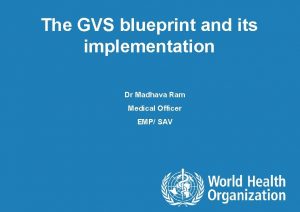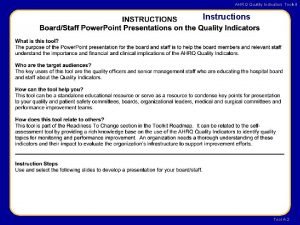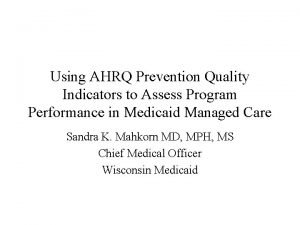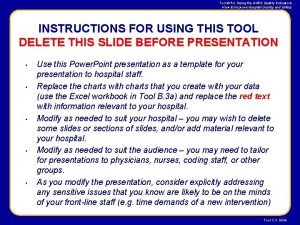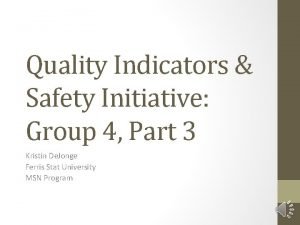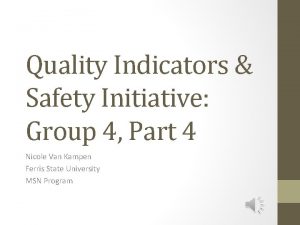Quality Indicators Safety Initiative Group 4 Part 5










- Slides: 10

Quality Indicators & Safety Initiative: Group 4: Part 5 Jessica Mc. Clusky Ferris State University MSN Program

NSI: Pediatric Pain AIR Cycle • Purpose (5) • Prevalence of completed pain cycles • Average length of time between cycles • Relationship between cycles and nursing hours worked • Definitions (5) • • Assessment Intervention Reassessment Complete Cycle • Nursing’s Role (2)

NSI: Pediatric Pain AIR Cycle • Schumann (2012) (7) • Pain scores for children over 24 hour periods • Intervened 75% of the time, regardless of pain score • 20% pain reduction for majority • Habich et al. (2012) (2) • Implementation of a standard pain AIR cycle • Increase in minimal pain assessment • 31% to 97 -98% • Increase in appropriate pain scale use • 51% to 92%

NSI: Pediatric IV Infiltration • Purpose (5) • Prevalence of peripheral IV infiltrations • Relationship between infiltrations and nurse staffing • Definitions (1, 5) • Infiltration/extravasation Infiltration Scale None No infiltration Grade 1 Skin blanched, edema less than 1”, cool, with/without pain Grade 2 Skin blanched, edema 1 -6”, cool, with/without pain Grade 3 Skin blanched, translucent, gross edema, cool, pain, numbness Grade 4 Skin blanched, translucent, leaking, bruised, gross edema circulatory impairment, pain • Nursing’s Role (8)

NSI: Pediatric IV Infiltration • Amjad, Murphy, Nylander-Housholder, & Ranft (2011) (1) • Interdisciplinary team • Importance of prevention and early detection • Simona (2012) (8) • Challenges current grading system • Identifies barriers to appropriate pediatric infiltration grading • Calls for further research

QSEN: Patient-Centered Care • Definition (5) • Impact on environment • Patient perceptions (4) • Parent perceptions (8) Nurse • Nursing’s Role (4) • My experience Family Patient Doctors Other members of care team

QSEN: Patient Centered Care • Jayadevappa & Chhatre (2011) (3) • Positive outcomes • Informed decision making • Trust • Webster (2013) (10) • Patient centered care with students • Simulation use • Need for repeated exposure and clinical competency experiences

Conclusion Safe and effective patient care Nursing Sensitive Indicators Quality and Safety Education for Nurses

References 1. Amjad, I. , Murphy, T. , Nylander-Housholder, L. , & Ranft, A. (2011). A new approach to management of intravenous infiltration in pediatric patients: pathophysiology, classification, and treatment. Journal Of Infusion Nursing, 34(4), 242 -249. doi: 10. 1097/NAN. 0 b 013 e 31821 da 1 b 3 2. Habich, M. , Wilson, D. , Thielk, D. , Melles, G. L. , Crumlett, H. S. , Masterton, J. , & Mc. Guire, J. (2012). Evaluating the Effectiveness of Pediatric Pain Management Guidelines. Journal Of Pediatric Nursing, 27(4), 336 -345. doi: 10. 1016/j. pedn. 2011. 06. 002 3. Jayadevappa, R. , & Chhatre, S. (2011). Patient-centered care—A conceptual model and review of the state of art. Open Health Services and Policy Journal, 4, 15– 25. 4. Lusk, J. M. , & Fater, K. (2013). A Concept Analysis of Patient. Centered Care. Nursing Forum, 48(2), 89 -98. doi: 10. 1111/nuf. 12019 5. National Database of Nursing Quality Indicators. (2009).

References 6. 7. Quality and Safety Education for Nurses. (n. d. ). Pre-licensure KSAs. Retrieved from http: //qsen. org/competencies/pre-licensure-ksas/#patientcentered_care Schumann (2012, January). Measuring improvement in pediatric pain: Modification of a pediatric pain measure to capture pain reduction. Poster presented at ANA Nursing Quality Conference, Las Vegas, NV. Retrieved from https: //ana. confex. com/ana/ndnqi 12/webprogram/Paper 6769. html 8. Simona, R. (2012). A pediatric peripheral intravenous infiltration assessment tool. Journal Of Infusion Nursing, 35(4), 243 -248. 9. Uhl, T. , Fisher, K. , Docherty, S. L. , & Brandon, D. H. (2013). Insights into Patient and Family-Centered Care Through the Hospital Experiences of Parents. JOGNN: Journal Of Obstetric, Gynecologic & Neonatal Nursing, 42(1), 121 -131. doi: 10. 1111/1552 -6909. 12001 10. Webster, D. (2013). Promoting Therapeutic Communication and Patient-Centered Care Using Standardized Patients. Journal Of Nursing Education, 52(11), 645 -648. doi: 10. 3928/01484834 -20131014 -06




